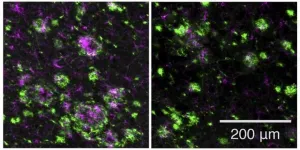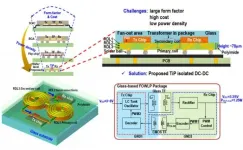(Press-News.org) A foundational study conducted by scientists at the National Renewable Energy Laboratory (NREL) shows for the first time that white-rot fungi are able to use carbon captured from lignin as a carbon source.
The research confirms a hypothesis from Davinia Salvachúa Rodriguez, the senior author of a newly published paper. Until now, scientists were unsure whether white-rot fungi--the most efficient lignin-degrading organisms in nature--actually consume the products generated from breaking down lignin.
"What we have demonstrated here is that white-rot fungi can actually utilize lignin-derived aromatic compounds as a carbon source, which means they can eat them and utilize them to grow," Salvachúa said. "That is another strategy for carbon sequestration in nature and has not been reported before."
The paper, "Intracellular pathways for lignin catabolism in white-rot fungi," appears in the journal Proceedings of the National Academy of Sciences. Her co-authors from NREL are Carlos del Cerro, Erika Erickson, Tao Dong, Kelsey Ramirez, Venkataramanan Subramanian, Rui Katahira, Jeffrey Linger, Wei Xiong, and Michael Himmel. Other co-authors are from the Environmental Molecular Sciences Laboratory at Pacific Northwest National Laboratory and the Joint Genome Institute at Lawrence Berkeley National Laboratory.
Salvachúa, a research scientist in NREL's Renewable Resources and Enabling Sciences Center, has spent more than a decade studying white-rot fungi. Last year, the Department of Energy's Office of Science awarded her a prestigious $2.5 million grant as part of the Early Career Research Program to further her work.
White-rot fungi evolved to degrade lignin, which Salvachúa calls "the most recalcitrant biopolymer on Earth." Lignin helps make the plant's cell walls more rigid. Other parts of the plant, such as cellulose, are also recalcitrant but can be fully depolymerized to single monomeric species for use as a biofuel and biochemical precursors, for example. But the intractability of lignin and the lack of an efficient method to deconstruct and convert lignin to monomeric compounds hampers the viability of plant-based biorefineries.
Salvachúa's work forms the foundation of a new research area based on lignin being broken down by white-rot fungi, which could be further exploited to simultaneously convert the biopolymer into value-added compounds.
The researchers examined two species of white-rot fungi: Trametes versicolor and Gelatoporia subvermispora. Through the use of genomic analysis, isotopic labeling, and systems biology approaches, the researchers determined the ability of these organisms to incorporate carbon from lignin-derived aromatic compounds into central metabolism and were able to map out the potential aromatic catabolic pathways for that conversion process. Further, in vitro enzyme analyses enable validation of some of the proposed steps. The researchers also highlight that this work is just the beginning of a broad area towards discovering new enzymes and pathways and better understanding carbon flux in these organisms.
Lignin accounts for about 30% of the organic carbon in the biosphere. Concerns about the changing climate have sparked a growing interest in the issue of carbon cycling, in which carbon is absorbed by natural reservoirs--such as plants--from the atmosphere and later decomposed and returned to the atmosphere or other natural reservoirs. Because more carbon is stored in the soil than in the atmosphere or plants, white-rot fungi are now positioned as key players in the sequestration of lignin-derived carbon in soils.
Scientists have demonstrated the ability of some bacterial strains to break down lignin as well, but not as effectively as white-rot fungi. Salvachúa said bacteria are easier to work with than fungi because they grow more quickly, and many are genetically tractable, contrary to white-rot fungi. "With fungi, one experiment can be up to two months," she said. "We try to be very careful when we plan an experiment because that's a long time. That's six experiments a year if you need results to move forward. With bacteria, you can do one per week."
INFORMATION:
The Department of Energy's Office of Science, Biological and Environmental Research program, funded a portion of the research, with other funding coming from the Laboratory Directed Research and Development program at NREL.
NREL is the U.S. Department of Energy's primary national laboratory for renewable energy and energy efficiency research and development. NREL is operated for the Energy Department by the Alliance for Sustainable Energy, LLC.
Inherited retinal dystrophy is a common cause of blindness, with as many as two million people suffering from the disorder globally. No effective treatment is available for retinal dystrophies. Gene therapy is expected to offer a solution, but developing such therapies is possible only when the genetic cause of the disease is known. Related mutations have been identified in more than 70 genes so far, but the genetic background of the disease remains unknown in as many as half of the patients.
"Retinal dystrophy has been described in over 100 dog breeds, with related investigations helping to identify new genes associated and pathogenic mechanisms with blindness across different ...
In a recent collaborative study led by the University of Maryland (UMD), researchers find that consumers tend to buy something less fuel efficient than they normally would for their second car after springing for an eco-friendly vehicle. While this sounds like an all-too-logical conclusion, the study reports a 57% reduction in the benefits of driving your fuel efficient car for carbon emissions purely based on the purchase of your second vehicle. Since about three-quarters of cars are purchased into multi-car households, these findings could have major implications for carbon emissions, and especially for the design of carbon mitigation programs like Cash-for-Clunkers and Corporate Average Fuel Economy (CAFE) standards that aren't taking ...
Philadelphia, March 2, 2021 - Researchers from the Mitochondrial Medicine Frontier Program at Children's Hospital of Philadelphia (CHOP) have demonstrated how one combination of therapies may be beneficial for patients with mitochondrial respiratory chain disorders. This preclinical research paves the way to develop more tailored treatment options for patients with inherited mitochondrial disease and acquired energy disorders. The findings emphasize the importance of rational therapeutic modeling to target specific cellular deficiencies and provide proper cellular nutrition as an effective means to manage mitochondrial disease.
The findings were published online ...
Optomechanical microcavities are extremely small structures with diameters of less than 10 micrometers (about a tenth of a human hair) inside which light and mechanical vibrations are confined. Thanks to their small size and to efficient microfabrication techniques that enable them to hold intense light energy and interact with mechanical waves, microcavities can be used as mass and acceleration sensors and in Raman scattering (a spectroscopy technique deployed to analyze materials, including gases, liquids, and solids). A sound understanding of these phenomena can contribute in future to advances in areas such as biomedicine, including the development of ...
The study gives the first detailed description of a volcanic eruption from Sierra Negra found on Isla Isabela - the largest of the Galápagos Islands and home to nearly 2,000 people.
The findings, published in Nature Communications, reveal how the volcano inflated and fractured before it erupted and captures a new level of detail for any eruption from a volcano on the islands.
Networks of ground-based seismic and GPS monitoring stations, and satellites, captured data for 13 years before Sierra Negra's eruption, in June 2018.
The surface of the volcano rose during this time, indicating a gradual accumulation of molten rock - known as magma - found in a reservoir under the ...
Ithaca, NY--The message about the bird-conservation benefits of shade-grown coffee may not be getting through to the people most likely to respond--birdwatchers. A team of researchers from the Cornell Lab of Ornithology and Virginia Tech surveyed birdwatchers to learn if they drank shade-grown coffee and, if not, why not. Their findings were published today in the journal People and Nature.
"One of the most significant constraints to purchasing bird-friendly coffee among those surveyed was a lack of awareness," said Alicia Williams, lead author and former research assistant at the Cornell Lab and Virginia Tech. "I was surprised to see that only 9 percent of those surveyed purchased bird-friendly ...
CHAMPAIGN, Ill. -- The liver has a rare superpower among body organs - the ability to regenerate, even if 70% of its mass is removed. It also keeps up its metabolic and toxin-removing work during the process of regeneration, thanks to a subset of cells that expand their workload while the rest focus on multiplication, a new study in mice found.
Furthermore, the cells of the liver communicate with each other to coordinate regeneration activity, which progresses from the center to the periphery of the missing liver lobes, researchers at the University of Illinois Urbana-Champaign said.
"It's remarkable how we still don't understand many aspects of liver regeneration," said Illinois biochemistry professor Auinash ...
Researchers at the University of California San Diego School of Medicine and Massachusetts General Hospital have identified a new drug that could prevent Alzheimer's disease by modulating, rather than inhibiting, a key enzyme involved in forming amyloid plaques in the brain. The study, which will be published March 2 in the Journal of Experimental Medicine (JEM), demonstrates that the drug is safe and effective in rodents and monkeys, paving the way for future clinical trials in humans.
A key pathological hallmark of Alzheimer's disease involves the formation of amyloid plaques composed of small protein fragments known as amyloid-β (Aβ) peptides. These peptides are generated ...
OAK BROOK, Ill. - Attendance at regular mammography screening substantially reduces the risk of dying from breast cancer, according to a large study of over half a million women, published in the journal Radiology. Researchers said women who skip even one scheduled mammography screening before a breast cancer diagnosis face a significantly higher risk of dying from the cancer.
Breast cancer screening with mammography has helped reduce disease-related deaths by enabling detection of cancer at earlier, more treatable stages. Despite mammography's well-established ...
Recently, research group led by Professor CHENG Lin from School of Microelectronics, University of science and technology of China has made significant achievements in the field of fully integrated isolated power chip design. They proposed a chip based on glass fan-out wafer-level package (FOWLP), achieving 46.5% peak transformation efficiency and 50mW/mm2 power density.
Compared with the traditional isolated power supply chip, this new design interconnects the receiving and transmitting chips through the micro transformer made of the rewiring layer, showing no need of additional transformer chips. In this way, it lowered the need ...






